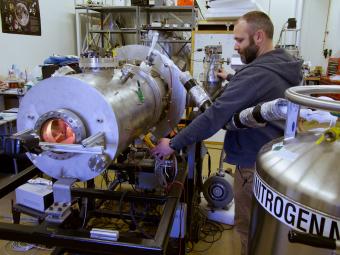Mines teams up with Pioneer Astronautics to advance sustainable lunar exploration
Researchers at Mines, Honeybee Robotics, NASA’s Johnson Space Center and Pioneer Astronautics will build hardware to produce oxygen and steel from lunar regolith

To develop the technology, the process needs to be tested under the vacuum and temperature conditions of the lunar surface using the appropriate regolith simulant – which is where Mines' Center for Space Resources comes in.
By Amy Brice, Special to Mines Newsroom
An interdisciplinary team of researchers from Colorado School of Mines is partnering with Pioneer Astronautics to advance technology that can take lunar regolith and transform it into oxygen and steel for use on the Moon.
Pioneer Astronautics, an aerospace research and development company located in Lakewood, Colorado, was one of four recipients of a NASA Small Business Innovative Research (SBIR) Phase II-S award to mature technologies that will enable a sustainable human presence on the Moon.
Together with Mines, Honeybee Robotics and NASA’s Johnson Space Center, Pioneer Astronautics will build and demonstrate hardware to produce oxygen and steel from lunar regolith. Such technology would provide a foundation for manufacturing operations on the Moon using local resources, a process known as in situ resource utilization or ISRU.
“The vision is to use local resources – lunar dirt – to make a feedstock that would then be used in a directed energy deposition additive manufacturing process to make metallic structures on the Moon,” said Craig Brice, director of Mines’ Advanced Manufacturing Program and ADAPT (Alliance for the Development of Additive Processing Technologies).
The system Pioneer Astronautics will develop is called Moon to Mars Oxygen and Steel Technology (MMOST). MMOST employs physical particle size sorting, electromagnetic regolith beneficiation (or improvement of physical and chemical properties), materials handling, hydrogen reduction, electrolysis, and melt-refining to produce metallic iron and oxygen products with minimal power requirements.
Mines’ role in the project is to use the reduced lunar regolith simulant produced by Pioneer Astronautics to create a feedstock wire that can be deposited using additive manufacturing techniques and to measure quality and performance throughout the process.
The team includes five professors across three innovative research centers at Mines: Angel Abbud-Madrid, Chris Dreyer, and Kevin Cannon from the Center for Space Resources; Brice from ADAPT; and Zhenzhen Yu from the Center for Welding, Joining, and Coatings Research.
To develop this technology, the process needs to be tested under the vacuum and temperature conditions of the lunar surface using the appropriate regolith simulant, said Abbud-Madrid, director of the Center for Space Resources.
“This is where our center’s unique facilities come into play,” he said. “Our vacuum chambers, cryogenic equipment, and expertise in developing lunar soil simulants will be important to this program.”
The Center for Welding, Joining, and Coatings Research likewise will be instrumental in developing an optimized procedure to convert the regolith simulant into wire feedstock for additive manufacturing deposition.
“The CWJCR has unique laboratory facilities for the design and pilot-scale manufacturing of consumables for welding, joining, and additive manufacturing,” said center director Zhenzhen Yu. Among CWJCR’s notable equipment are a tubular drawing mill for experimental consumable wire manufacturing and an ultrasonic resonance particle mixer.
ADAPT has expertise in wire-fed metal additive manufacturing and will oversee the deposition of the regolith feedstock wire into samples that will be evaluated for performance.
Following development and testing by the Pioneer/Mines team in Colorado, MMOST will be demonstrated as an integrated system inside Johnson Space Center’s 15-foot vacuum chamber, bringing it to technology readiness level 6, or TRL 6. TRL 6 indicates that a system model or prototype has been demonstrated in a relevant environment and is ready to move on to demonstration in space. After testing, MMOST will remain at JSC for further testing as needed with other technologies.
The Mines team is proud to be part of this technology advancement. “It is exciting to participate in a project that will get us one step closer to reducing our dependence on Earth materials in space by enabling us to manufacture parts from lunar resources,” Abbud-Madrid said.




